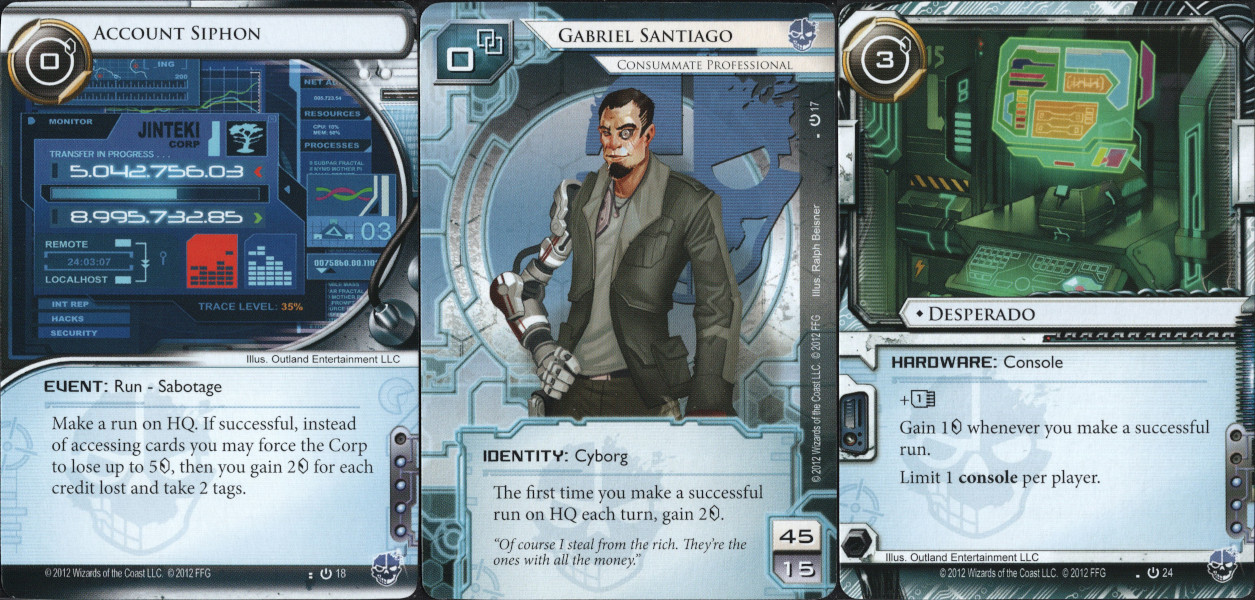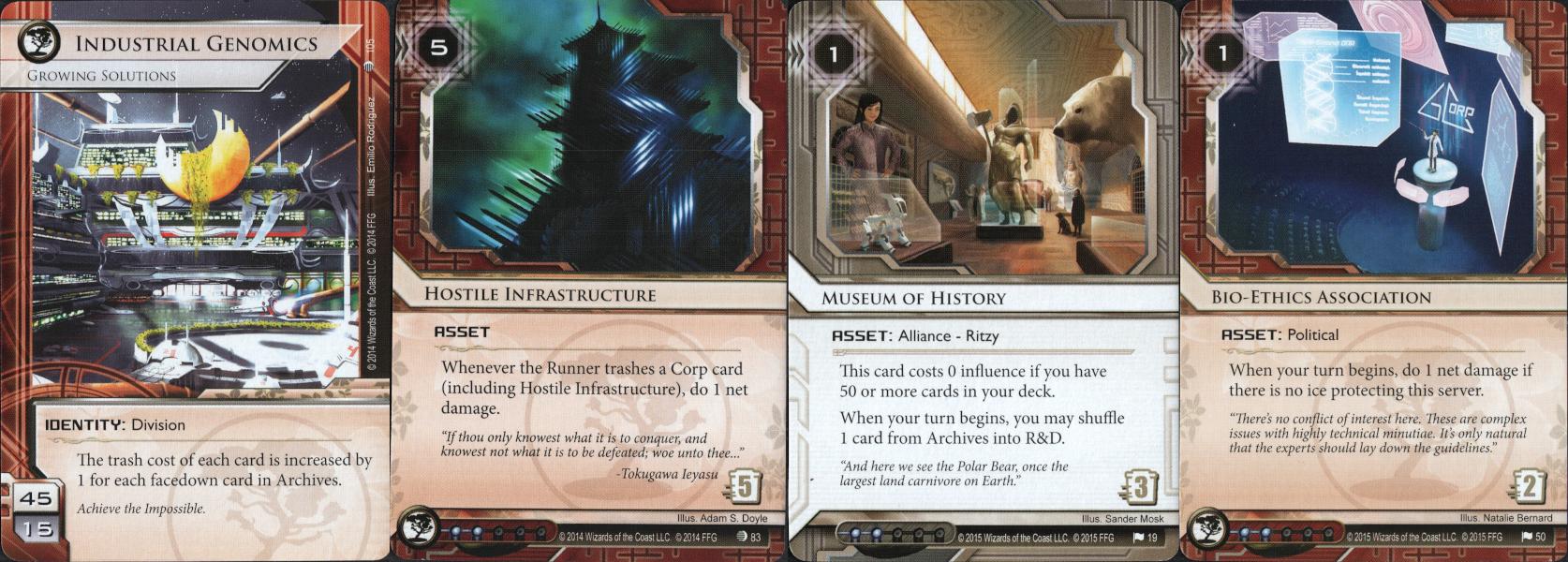Texturing the Game
Android: Netrunner (A:NR) was one of Fantasy Flight’s “Living Card Games” (LCGs). These are a line of card games where you buy some base or “core” set of cards, and the publisher releases smaller additional packs each with a fixed set of cards.
In the early years of A:NR’s run, the single most controversial card was Account Siphon (“Siphon”), pictured below alongside other cards that synergised with it. A lot of words were written about Siphon, arguing that it was “overpowered”, or “balanced”, or “unfair”. In this article, I’m not going to argue those questions. I’m instead going to talk about how Siphon warped the rest of A:NR around itself, and that it is good to have cards like because they give a game something I call “texture”.

Account Siphon
(Skip this section if you already know A:NR.)
For those who never played A:NR, here’s how it worked. The main interaction between the two players is when the runner makes a “run” on one of the corp’s “servers” - their hand (HQ), draw deck (R&D), discard pile (Archives) or other cards on the table. Normally, this allows the runner to access the corp’s cards, meaning that they gain information about what cards the corp has, can trash assets and upgrades, steal agendas (which is how the Runner wins) and sometimes faceplant into nasty traps.
Siphon allows the runner to directly attack the corp’s credit pool. The runner spends one of his or her four actions, and if he or she makes it through, drains up to five credits and gains two credits for every one stolen. How bad is losing five credits to the corp? Pretty dire, most of the time. If the corp doesn’t have economy cards handy, then he or she can only gain one credit per action, and at three actions per turn, that’s nearly two full turns spent trying to scrounge up funds. Worse, most corp economy cards are of the “spend money to make money” type: Hedge Fund appears in nearly every Corp deck, requires five credits to play and returns nine credits when it resolves, for a net gain of four credits. Great if you can afford it, but if you’ve been Siphoned into the poorhouse then it’s not going to save you. Add in the triggers from Gabriel Santiago and Desperado, also above, and you have a 13-credit swing in a single action! Exhilarating when you pull it off, and very demoralising to face.
It’s not all upside for the runner, though. If the runner takes any credits at all from the corp, he or she also gets two tags, which represent the corp knowing the runner’s location or identity. “Being tagged” allows the corp to trash any resource cards the runner has installed, as well as play the nastier cards, potentially wiping the runner’s bank balance or blowing up the runner’s apartment block, the latter of which can win the game outright. The runner can drop tags at a cost of two credits and an action per tag, which means that if you’re paranoid, you can siphon and get away by spending three-quarters of your turn to make six credits. The payoff is no longer so great - two credits per action - but you still hurt the corp’s bank balance. To get the big rewards you have to accept the bigger risks.
Siphon Warps Everything
For a large chunk of A:NR’s history, if you were a corp player and you saw a blue (Criminal) identity on the other side of the table, you expected three copies of Siphon in the runner’s deck. After a few rounds of getting their credit pools sucked dry, corp players became wise to Siphon, and learned how to defend against it. How? The obvious first step is to prioritise HQ defence against Criminal runners. But there are a lot of other plays corps can make.
The corp plays almost all of its cards face-down, and may later spend money to turn them face-up (“rez” them). This allows a savvy corp several options:
Keep unrezzed (facedown) defences over HQ, and specifically defend with cards that end the run. Allow the runner’s normal runs in, and only rez these defences in response to a Siphon run, so that the runner is never certain that he or she has the necessary tools to pull off the heist.
Keep unrezzed assets on the table, and rez them just before a successful Siphon run connects. The aim here is to get down to two or three credits, as that’s probably not worth the runner eating the two tags to steal. Even better if you do this with economy assets that generate money over future turns.
To make these plays available, the corp must keep his or her credit pool from growing too large, often by holding back cards like Hedge Fund as a way to burst back up.
Runners then learned to use Siphon as a way to trigger these responses: if the corp has spent a lot of money protecting HQ, then they can’t afford to protect their other servers. If they’ve rezzed assets, that’s one fewer card that could be an agenda, and so on.
All of this comes from having one card with a big, faction-defining effect, and this is the sort of thing I mean by “texture”. Siphon says “this is what it means to play (as/against) Criminal”, and even to some extent “this is what it means to play A:NR”, as other factions sometimes sneak a cheeky copy or two into their decks.
Texturing
Account Siphon exemplifies the entire Criminal playstyle but texturing isn’t just allocating powers to factions. Texturing says “this is the sort of thing that happens in this game”, and I think it’s one of the factors that turns a game from a ruleset into something gripping.
A game’s theme is partly brought to life though mechanical texture, but that requires that the cards find their way into the decks people play. Apocalypse changed the texture of the game. Shoot the Moon did not - if you could stick that many tags, you’d play BOOM! instead and win the game.
Corollary: it is easier to texture a newborn game than a mature one, as cards that change the texture need to see a lot of play. If later cards are radically changing the texture of the game, this often means power creep or radically new and different abilities. The former is clearly unhealthy, and the latter risks breaking the agreement between designer and players about what the game is.
The first deluxe expansion, Creation and Control, upended the playstyle of the Shaper runner faction. Self-Modifying Code (SMC) and Clone Chip added the ability to fetch tools mid-run, and a runner with SMC on the table and a big stack of cash became an intimidating prospect for the corp. The ability to find, recur and install tools just-in-time is now affectionately known as “Shaper BS”.
Texturing can Age Badly

ICE destruction has been a core part of A:NR’s texture since the original Core Set, in the form of Parasite and Datasucker. Datasucker is clearly designed to work alongside with Parasite, to allow the runner to hurry along the demise of problem ICE. To set this up with just the core set, the runner had to:
- Force the corp to rez the ICE, usually by running into it, and then either eating its effects or paying to break it with ICE breakers.
- Install Parasite.
- Run again, and then use Datasucker to reduce the ICE strength to 0 so that Parasite would destroy it.
Then Creation and Control happened, and runners could destroy ICE on the fly by pulling Parasite from the deck with SMC or from discard using Clone Chip, and Datasuckering it to zero on the first run in. At its worst, this seriously damaged the texture of the game. When ICE destruction was that easy, low-strength ICE became nearly irrelevant and it was very hard to design compelling cards that derezzed ICE instead of destroying it outright.
This is one reason why healthy, long-lived card games need some sort of banning or rotation policy: cards that did good work setting up the initial texture of a game can constrain a mature cardpool. Another example: Scorched Earth did great work texturing the Core Set but constrained the design space for tags; as long as it was legal to play, the biggest state change a single tag can inflict is “you lose”. Tagging, tag prevention and damage prevention all had to be costed accordingly.
Late in A:NR’s commercial run, Fantasy Flight introduced a Revised Core Set without Parasite (removing it from competitive play), and printed Trypano in one of the last packs it produced. NISEI, the fan community that maintains A:NR now that its commercial run has ended, also had a go with Chisel. Chisel behaves a lot like Parasite, but uses subtle points in the timing rules to prevent the interactions which made mid-run Parasite get out of hand.
Texturing Going Wrong

If radical changes undermine the common understanding of what the game is, changing the texture becomes a big problem. This, IMHO, is why IG54-style decks became so hated: a few key cards from the Mumbad cycle enabled a style of play so different from the existing texture of A:NR that people preferred quitting the game to dealing with those decks. Unlike the responses to Siphon discussed above, the response to the IG54 prison decks was “play Whizzard with Salsette Slums, Employee Strike and possibly Scrubber”. It was almost impossible to compete using in-game responses; runners had to include a lot of specific cards just for that matchup.
So what makes for good texturing? I haven’t got a complete idea, but there are a few things I consider necessary:
- Effects powerful enough to warp the game around themselves, that align with what people already understand the game to be about.
- Counterplay is possible within the fundamental rules of the game, without needing many specific “tech” responses.
- A plan to manage the texturing as the game matures, so that early decisions do not overly constrain the design space.
Not Texturing
What happens if you don’t texture your game? Petroglyph’s 8-Bit Armies is a really good example from PC gaming. Petroglyph was formed from a lot of ex-Westwood people, and 8-Bit Armies was advertised as a “retro RTS”, calling back to the mechanics of the old Command & Conquer games (mostly the “sidebar” style of RTS interface).
It was completely soulless. You had the choice between two slightly different sides, both vaguely-military soldiery dudes in khaki. Contrast that with the ridiculous stuff that was put into the C&C games: Obelisks of Light! Tunnelling flamethrower tanks! Prism towers! Chronosphere! Kirov Airships! Kane! It was all ridiculous, but it gave those games texture, and created a fanbase devoted enough that EA is now remastering the old C&C titles.
Closing Thoughts
I find it very hard to enjoy a game if it’s not well-textured. I don’t get excited about whether to include Process Automation over Build Script. I think games are much better when they have Siphon-tier effects, effects that really put a stake in the ground and say “this is what this game/faction/playstyle is about”.
Texturing and mechanical design seem intertwined, as texturing a game needs a good understanding of its mechanics, and designing mechanics needs a good understanding of what textures it should support.
If you want to read more in this space, I recently found two old articles by SimonMoon that cover similar topics, but assume a lot more netrunner knowledge. These articles don’t give a name to what I call “texture”, but make the case that the texturing varies the landscape of threats each player makes: